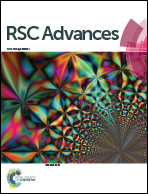Freshness monitoring of raw fish by detecting biogenic amines using a gold nanoparticle-based colorimetric sensor array†
Abstract
We herein report the quantitative detection of biogenic amines using a gold nanoparticle-based colorimetric chemosensor array for food analysis. The gold nanoparticles are functionalized with carboxylate derivatives, which capture target amines through hydrogen bonds and electrostatic interactions. The simultaneous discrimination of 10 amine derivatives was achieved by a linear discriminant analysis with a 100% correct classification based on the multi-colorimetric response pattern of structural differences. Furthermore, a real sample analysis for raw fish (i.e., tuna) demonstrated highly accurate determination of histamine concentrations by a support vector machine, the result of which was matched with high-performance liquid chromatography. Most importantly, the chemosensor array succeeded in detecting the time-dependent concentration change of histamine in the raw fish, meaning that the decomposition of the fish could be monitored by the colorimetric changes. Hence, the proposed chemosensor array combined with pattern recognition techniques can be a user-friendly analytical method for food freshness monitoring.



 Please wait while we load your content...
Please wait while we load your content...